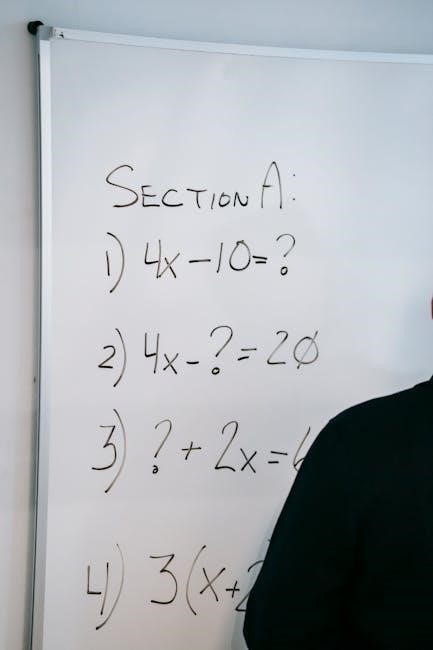Special education lesson plans are tailored to meet the unique needs of diverse learners, ensuring structured and accessible learning experiences. These plans are essential for promoting academic and personal growth, providing clear objectives, materials, and activities that cater to individual requirements. By focusing on specific goals and accommodations, they help educators create an inclusive and effective learning environment.
Overview of Special Education
Special education refers to tailored educational services designed for individuals with unique learning needs, such as disabilities or developmental delays. It emphasizes addressing diverse requirements through personalized instruction, accommodations, and support. Special education programs are often guided by legal frameworks like the Individuals with Disabilities Education Act (IDEA), ensuring access to free and appropriate public education. These programs operate in inclusive or specialized settings, focusing on academic, social, and life skills development. Teachers collaborate with parents, therapists, and specialists to create adaptive learning environments. The goal is to empower students to achieve their potential by addressing individual challenges and fostering independence. Special education encompasses a wide range of strategies, from modified curricula to assistive technologies, ensuring equitable opportunities for all learners.
Importance of Lesson Planning in Special Education
Lesson planning is crucial in special education as it ensures that instruction is tailored to meet the unique needs of each student. A well-structured plan aligns with Individualized Education Programs (IEPs), helping teachers address specific learning objectives and accommodations. It provides clarity and direction, making it easier to track student progress and adapt teaching strategies as needed. Lesson plans also promote organization, ensuring that materials and resources are readily available, and help maintain consistency, which is vital for students who thrive on routine. Additionally, they facilitate communication among educators and support staff, ensuring a cohesive approach to teaching. Effective lesson planning in special education fosters a structured learning environment, enabling teachers to manage diverse needs and create meaningful learning experiences that cater to each student’s abilities and goals.

Key Components of Special Education Lesson Plans
Special education lesson plans include learning objectives, materials, activities, and assessments, ensuring tailored instruction for diverse learners with specific needs and accommodations.
Learning Objectives and Goals
Learning objectives and goals are the foundation of special education lesson plans, ensuring clear direction and measurable outcomes for students. These objectives are typically specific, measurable, achievable, relevant, and time-bound (SMART), aligning with individualized education programs (IEPs). They guide instructors in tailoring activities and assessments to meet diverse learner needs; For example, a lesson might aim for students to recall family members or demonstrate appreciation through active participation. Objectives also focus on social-emotional and life skills, fostering holistic development. By defining these goals, educators create a roadmap for instruction, ensuring that each activity and assessment supports student progress. This structured approach helps track advancements and adapt plans as needed, providing a personalized and effective learning experience.
Materials and Resources Needed
The success of special education lesson plans depends on having the right materials and resources. These may include adapted worksheets, visual aids, assistive technologies, and sensory tools. For example, PDF templates provide structured formats for creating detailed plans, while platforms like Teachers Pay Teachers offer downloadable resources tailored for diverse learners. Websites such as Education World and K12Reader provide free printable materials, including math worksheets and reading guides. Additionally, life skills resources, like scope and sequence plans, help teachers address practical needs. Online communities, such as Share My Lesson, offer comprehensive collections of special education materials. These resources ensure that lessons are engaging, accessible, and aligned with individual student needs. Having the right tools and materials is crucial for creating an inclusive and effective learning environment.
Activities and Instructional Strategies

Effective special education lesson plans incorporate a variety of activities and instructional strategies to engage diverse learners. These may include hands-on tasks, group discussions, and visual aids to cater to different learning styles. Structured literacy approaches, such as Reading Intervention, ensure that skills are taught sequentially. Activities are often adapted to meet individual needs, with modifications like tracing exercises for fine motor skills or assistive technologies for accessibility. Social-emotional learning is also integrated, with activities that promote self-awareness and interaction. Teachers use strategies like differentiated instruction and scaffolding to break down complex concepts. Additionally, life skills activities, such as math tasks for real-world application, are included to enhance practical learning. These strategies ensure that lessons are interactive, meaningful, and tailored to the unique requirements of each student. By incorporating diverse activities, educators create a dynamic and inclusive learning environment.

Creating Effective Special Education Lesson Plans
Effective lesson plans in special education focus on structured literacy, clear objectives, and tailored activities. They incorporate assessments, modifications, and resources like PDF templates to ensure accessibility and engagement for diverse learners.
Assessment and Evaluation Methods
Assessment and evaluation are critical components of special education lesson plans, ensuring that teaching strategies align with student progress. Formative assessments, such as skill checks and progress monitoring, help track individual growth. Summative evaluations, like quizzes or projects, measure mastery of objectives. Teachers use these methods to identify strengths, address gaps, and adjust instruction. Many PDF templates include sections for documenting baseline data, allowing educators to compare pre- and post-assessment results. Performance tasks and observational notes also provide insights into students’ understanding. By incorporating multiple assessment types, teachers can evaluate whether modifications and accommodations are effective. Regular evaluation ensures that lesson plans remain tailored to students’ needs, fostering an adaptive and supportive learning environment. This continuous cycle of assessment and adjustment is key to maximizing student outcomes in special education.
Modifications and Accommodations for Diverse Learners
Modifications and accommodations are essential in special education lesson plans to ensure all students can access and engage with the curriculum. Modifications involve altering the content or expectations to meet individual needs, such as simplifying assignments or reducing workload. Accommodations, on the other hand, provide support without changing the learning goals, like using assistive technology or offering extra time for tasks. For example, visual aids or peer assistance can help students with disabilities or learning challenges. These strategies are tailored to individualized education programs (IEPs) and 504 plans, ensuring equity and inclusion. By integrating modifications and accommodations, educators create a more responsive and effective learning environment, fostering independence and academic success for diverse learners. These adjustments are critical for addressing unique needs and promoting meaningful participation in lessons.

Resources for Special Education Lesson Plans
Educators can access various resources, including PDF templates and downloadable plans, from platforms like Teachers Pay Teachers, Share My Lesson, and Education World. These sites offer diverse materials.
PDF Templates and Examples
PDF templates for special education lesson plans provide structured frameworks for teachers to design effective and organized instruction. These templates often include sections for learning objectives, materials, activities, and assessments, ensuring clarity and comprehensiveness. Examples of such templates can be found on platforms like Teachers Pay Teachers and Share My Lesson, which offer customizable and downloadable resources. For instance, templates may include spaces for baseline data collection, accommodations, and specially designed instruction (SDI), catering to diverse learner needs. Additionally, websites like Education World and K12Reader offer free printable resources and lesson plan examples tailored for special education. These tools help educators save time while creating detailed, goal-oriented plans. Many templates also incorporate examples of activities and instructional strategies, providing guidance for new teachers or those seeking inspiration.
Online Platforms for Downloadable Plans
Several online platforms offer downloadable special education lesson plans in PDF format, providing teachers with convenient access to high-quality resources. Platforms like Teachers Pay Teachers and Share My Lesson feature extensive collections of customizable templates and lesson examples tailored for diverse learners. These resources often include detailed activities, accommodations, and assessments, making it easier for educators to implement structured learning experiences. Additionally, websites such as Education World and K12Reader offer free printable materials and lesson plan examples specifically designed for special education. These platforms cater to a wide range of needs, allowing teachers to download and adapt plans to suit their students’ requirements. By leveraging these resources, educators can save time while ensuring their lesson plans are comprehensive and effective.
Special education lesson plans are vital tools for creating structured, inclusive learning experiences. They ensure that diverse learners receive tailored support, fostering both academic and personal growth effectively.
Best Practices for Implementing Lesson Plans
Effective implementation of special education lesson plans requires collaboration with IEP teams, incorporating accommodations, and using assessments to track progress. Start by aligning lessons with IEP goals and ensuring activities are engaging and adaptable. Use universal design for learning (UDL) principles to cater to diverse learning styles. Regularly monitor student performance and adjust strategies as needed. Leveraging technology, such as interactive tools, can enhance engagement and accessibility. Provide clear instructions and visual supports to aid understanding. Encourage active participation and positive reinforcement to build confidence. Collaborate with parents and therapists to ensure consistency in learning. Finally, reflect on each lesson to identify strengths and areas for improvement, ensuring continuous growth for all students. By following these practices, educators can create meaningful and impactful learning experiences tailored to each student’s needs.
